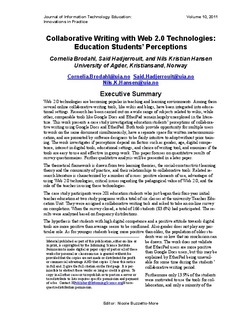| dc.identifier.citation | Brodahl, C., Hadjerrouit, S., & Hansen, N. K. (2011). Collaborative writing with web 2.0 technologies: education students' perceptions. Journal of Information Technology Education, 10, IIP73-IIP103. Retrieved from http://jite.org/documents/Vol10/JITEv10IIPp073-103Brodahl948.pdf | no_NO |
| dc.description.abstract | Executive Summary Web 2.0 technologies are becoming popular in teaching and learning environments. Among them several online collaborative writing tools, like wikis and blogs, have been integrated into educational settings. Research has been carried out on a wide range of subjects related to wikis, while other, comparable tools like Google Docs and EtherPad remain largely unexplored in the literature. This work presents a case study investigating education students' perceptions of collaborative writing using Google Docs and EtherPad. Both tools provide opportunity for multiple users to work on the same document simultaneously, have a separate space for written metacommunication, and are promoted by software designers to be fairly intuitive to adopt without prior training. The work investigates if perceptions depend on factors such as gender, age, digital competence, interest in digital tools, educational settings, and choice of writing tool, and examines if the tools are easy to use and effective in group work. This paper focuses on quantitative results of survey questionnaires. Further qualitative analysis will be presented in a later paper. The theoretical framework is drawn from two learning theories, the social-constructivist learning theory and the community of practice, and their relationships to collaborative tools. Related re-search literature is characterized by a number of issues: positive elements of use, advantages of using Web 2.0 technologies, critical issues regarding the pedagogical value of Web 2.0, and the role of the teacher in using these technologies. The case study participants were 201 education students who just began their four-year initial teacher education at two study programs with a total of six classes at the university Teacher Education Unit. They were assigned a collaborative writing task and asked to take an on-line survey on completion. When the survey closed, a total of 166 students (83.6%) had participated. The results were analyzed based on frequency distributions. The hypothesis that students with high digital competence and a positive attitude towards digital tools are more positive than average seems to be confirmed. Also gender does not play any particular role. As for younger students being more positive than older, the population of older students was so low that no conclusion can be drawn. The work does not validate that EtherPad users are more positive than Google Docs users, but this may be explained by EtherPad being unavailable for some time during the students' collaborative writing period. Furthermore only 13.9% of the students were motivated to use the tools for collaboration, and only a minority of the students (15.7%) reported that the quality of collaboration in the group increased with use of the tools. Likewise, the tools did not work as expected for a majority of the students (70.5%). Forty-seven percent of the students liked to comment and edit others contributions to group work. Although the results cannot be generalized to a larger group of students, and no definite conclusions can be drawn from the questionnaires about the usefulness and effectiveness of Google Docs and EtherPad for collaborative writing, the results cannot be underestimated since some results are consistent with the research literature. Future research consists of the qualitative evaluation of the students' comments to open ended-questions in the questionnaire, the students' collaborative essay papers, and their contributions to group work. It may also be important to examine the extent and quality of utilization of the tools for collaborative writing. Triangulation of the data collected may shed light on how they really perceived the effectiveness of Google Docs and EtherPad to support collaborative writing among students | no_NO |
